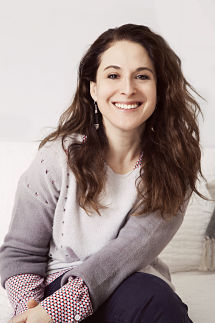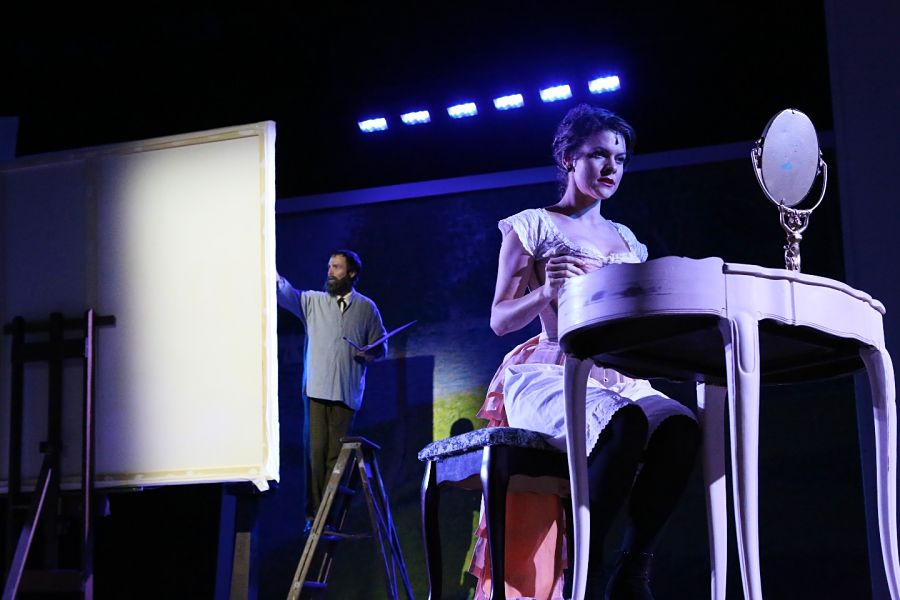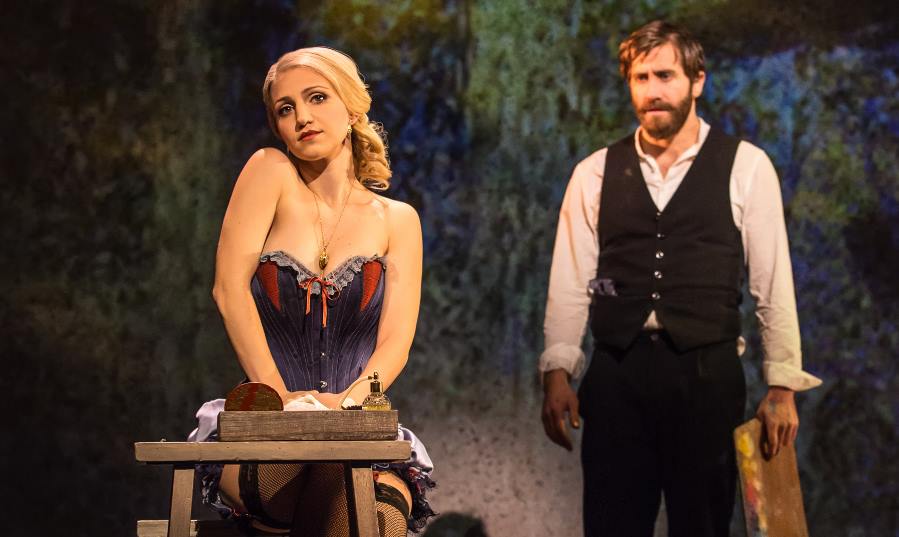The thing about classics isn’t that they are timeless—a word that suggests greatness suspended in amber, destined to mean the same thing for all time. No, one reason masterpieces seem to stick around through changing times is because they themselves seem to change and grow along with us; they look and feel different depending on who’s on the receiving end and where they are in their lives. If art is a mirror help up to nature, as one unbreakable classic has it, it only makes sense that it would have different things to say to different people across the years (and of course we ourselves are different people across the years).
This truth is resoundingly affirmed by the current Broadway revival of Sunday in the Park With George, at the Hudson Theatre through April 23. It certainly says something different to me than it ever has before: While I’ve always admired this 1984 musical about art, time, memory, legacy, and love, I’ve often been left cold by its time-jumping second act. If director Sarna Lapine deserves credit for nothing else—and to my mind she deserves all kinds of credit—it is for somehow making the two halves of this great musical cohere, not only intellectually but emotionally. The dots converge in this new Sunday in a new and transformative way.
Of course, Lapine has nonpareil partners in Chris Fenwick’s sensitive music direction, Beowulf Boritt’s unobtrusive set design, Tal Yarden’s projection design, Ann Yee’s musical staging, and a remarkable, dare I say overqualified ensemble of musical theatre powerhouses headlined by Annaleigh Ashford and Jake Gyllenhaal. (Oh, and that Chromulume!) But the production’s particular magic—which began in a special concert rendering last year at New York City Center—clearly starts at the top with Lapine. In a recent phone interview, I didn’t quite uncover her secret to cracking Sunday’s enigma code, except to learn that it is a bit of a family secret. She clearly has an abiding personal connection to this great musical that goes beyond the fact that her uncle, James Lapine, wrote the book and directed the original production.

ROB WEINERT-KENDT: You’re talking from a Seattle area code. Is that where you’re from?
SARNA LAPINE: No, I grew up in Connecticut, but I went to school in Seattle. I was very into the outdoors, and ended up being a mountaineer and a climbing guide. I only got into theatre because I met Bartlett Sher when he was at the Intiman Theatre.
You ran all the way to the West Coast, but theatre still found you.
Yeah. It’s not that I hadn’t seen all of my uncle’s work, but I was not interested in theatre then. I studied English literature and anthropology. But I happened to meet Bart when I was working in the nonprofit sector and running a program for girls in juvenile detention. I met him through Laura Penn, who was the Intiman’s managing director, and I got a job running their education department. I got to know Bart and I asked him: How did you get to do this for a living? How did you get good at it? He told me: “I had great mentors, I did a lot of assisting. I’m about to go New York to do my first Broadway show. If you come, you can assist me.” That was Light in the Piazza, and that was my first job as an assistant director on Broadway.
Then I did Awake and Sing with him, and all the South Pacific touring productions. Then Lincoln Center ask me to be an associate on War Horse, which I did for two and a half years and took to Tokyo.
What is your history with Sunday in the Park With George?
I saw the original Broadway production when I was 8 years old. I have a vivid memory of it—of how I even got to go to the show. My parents weren’t going to take me. They thought I wouldn’t understand it, that I’d be bored, that I would be antsy. They’d been to a lot of theatre in New York without me, and that bothered me; I insisted that they take me. So I was there with all my aunts and uncles, and we were at the back of theatre, and I was sitting on a pile of coats. I was totally mesmerized and deeply, deeply moved by the show. I remember James taking us backstage to show us how the set worked. I remember the sketches of the costumes.
We had a tape deck in the car, and I memorized the score because I just wanted to carry it around with me. So it’s a show I’ve spent a lot of years thinking about. At the time it came out, it was a rather intellectual musical; it has a lot of incredible ideas in it, which was rare for a musical in its time. People who know me may dispute this, but I’m actually very shy and introverted person, and as a kid I was kind of in my head a lot. And nothing felt as profound to me, even as an 8-year-old, as this show. That’s why it stayed with me—with a lot of us—over the years.
And then you had a chance to direct it, even before last year’s City Center concert, right?
I directed it at a small theatre in Columbus, Ohio, Short North Stage. It was a really wonderful experience. What I discovered there was how deeply I’d digested this show. I had feelings about the music—I’m not a musician, but I had a sense of the dynamics of it, and how that should shape the staging and the transitions. The show was inside of me in a way, whereas most shows you’re learning as you go. In some ways it’s one of the easiest experiences I’ve ever had, directing it there; the Lapines were original from Mansfield, Ohio, and both my parents went to Ohio State. So it was labor of love without any pressure.

Did you ask your uncle for advice along the way?
We had a number of email exchanges. He did send me a brief sentence or two. He said: “I’m touched that you’re doing this show—it’s what the show is about, children and art.”
I’ve always found it funny that people see Sunday as a personal expression, even as quasi-autobiographical, for Stephen Sondheim. But there’s a lot of James Lapine in it too. Isn’t there?
I talk about that more privately than publicly, but I feel that very deeply in the DNA of the show. The show is the beautiful result of a collaboration between two very different kinds of artists, and the alchemy is in the end result. That’s part of what’s so moving to me. So much of my career has been with more experienced artists who I’ve been learning from. And that’s how I feel about Act One and Act Two; they’re so much in relation to each other. There’s a podcast by Malcolm Gladwell called Revisionist History, and there’s an episode he does called “Hallelujah.” It’s such a great glimpse into how artists are in conversation with each other, and with their own work, over time. The minute I heard that I thought of Sunday.
When you say that Sondheim and Lapine are two totally different artists, what you do mean?
They were coming with totally different backgrounds and experience. Stephen had had a successful career in Broadway musicals, and James was a visual artist. They were living in two different worlds in New York City; there was an uptown-and-downtown element to it. But they share a sense of how to investigate material, and an interest in the lives of their characters. They were a great intellectual match for each other.
Since you use the word intellectual, I have to admit: The second act has always left me cold. I’ve always known what it’s trying to say, but I’ve never felt it—until your production. I’m sold. What’s the secret?
This is something I haven’t really shared, but I’m happy to tell you about, because I’m really proud of it. When I did the show in Columbus and my parents were there—they’ve seen every iteration of Sunday, and my dad came up to afterward and said to me, “I don’t know what you did, but I suddenly felt Act Two in a different way.” That was the greatest moment.
When I did it at City Center, I knew in my heart that there was something I felt in Act Two that had come out in the production. I don’t know if should talk too much about it. It’s very personal. I felt a great love for the piece as a whole, even from moment I saw it, and I’ve heard people criticize Act Two my whole life. I’ve thought about this piece, both intellectually and very personally, and I had a sense of what the bones of Act Two could be—how it connected to Act One. A lot of it has to do with time.
Do you mean time as it works in the show, or the time you’ve had to digest the material?
What I will say: I could not have arrived at this version if not for the other versions that preceded it. It’s not about being better or more right. I’ve been inspired by the choices that others have made. For myself, I had no idea that saying yes to a production in Ohio—which I almost said no to—would lead to this. You can’t plan that.
One theory I have about why your version works so well: The second-act George is not really a fully realized character; he’s more of a continuation of the first act’s George, and he’s only around to learn what his great grandfather couldn’t, and to achieve a kind of closure with his art and with Dot.
Let me add to this from the point of view a young woman. The key is in fact Dot. How incredible that the lover and the model is also the artist’s muse in the first act, and by the end of the second act she’s become his teacher. I believe that James has always maintained an interest in Carl Jung and the collective unconscious; he wrote about that in 12 Dreams, and I find that subject matter very interesting too. The point being, James understands symbolism and psychology in a visual way, a theatrically magical way, and I feel that in this piece. The less literal I had to be about some of the period details, the better. I mean, they’re all the same people 100 years later, in a way, but the relationships have all shifted slightly. Also, in the first act, I was thinking: How literal do we have to make the painting? Maybe George only sees shapes and colors; maybe he only cares about bodies and space. We don’t have to fill all that in, partly because James Lapine did it so fully in the original production, and that’s in our minds already.
Can you tell me about working with Jake and Annaleigh? They’re really quite something, individually and together.
It’s all a conversation. That’s the best thing about being a director, as opposed to being a writer: You just want to be in a great conversation with a lot of smart people. Stephen and James have created something that people love, and it has an intense beating heart at the center of it. Both in the score and the scene work, Annaleigh and Jake are both very intelligent actors and they’re very alive in the present moment. They’re both very heart-centered creatures. And George and Dot are equals. They’re living in a particular time where they’re not supposed to be equals, but there’s such a strong sense of partnership. It comes alive in this portrayal of George and Dot in a very intense way.
I felt that intensity, but I also felt the value of restraint in this production, of underplaying. Did you ever find yourself giving the note, “Do less, hold back”?
I never said that. But I do think that in this particular production I had a lot of private and individual note sessions with people in an ongoing way, where the conversations were about: The key is what’s happening inside of you in this world. The opening song, for instance, is about a woman who is in physical pain. And it’s funny. But what’s really going on inside of her in the midst of this experience? That’s for us to explore on any given day.
I don’t really care about Tony Awards, but it’s a shame that you and this production aren’t eligible.
In all honesty, I don’t mind saying, I love this piece so much, and I’m so proud of it that I’m just incredibly gratified that people enjoy it as much as those of who worked on it. It’s a great gift to be able to share it. I don’t mean to sound cheesy, but for me that’s what it’s all about. That’s enough. I’m not in the awards business. Also, it’s my first Broadway show! I’m just really happy we got to do it, and that I got to do at this point in my life.
We’re all living in a really hard moment right now. And this piece is about how ephemeral life is, and about how enduring a work of art is. I mean, we are in conversation with Seurat—that is pretty wild.


